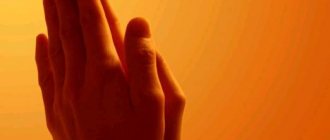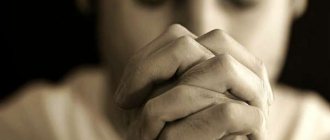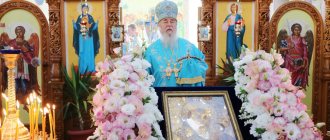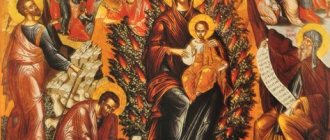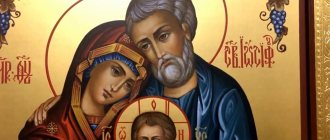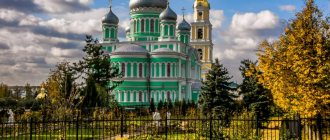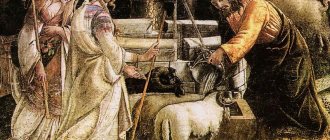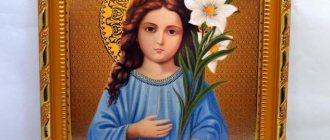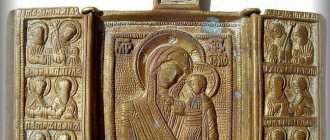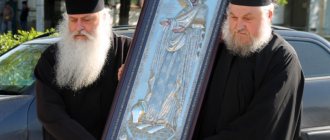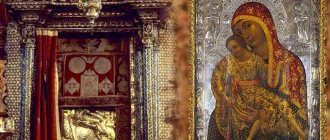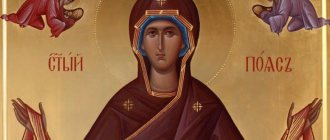The icon of the “Savior Not Made by Hands” is one of the few images of the Savior that is recognized and endlessly revered by both the Catholic and the more orthodox Orthodox Church.
This image is present in almost all Orthodox churches and home iconostases. It is with “The Savior Not Made by Hands” that icon painters begin their creative and godly path. But it is believed that the prototype was not written by a human hand, but appeared miraculously. That is why the Savior is called “Not Made by Hands.”
A bit of iconography
The canonical iconography of Jesus Christ is not so diverse in comparison with the Mother of God or St. Nicholas the Wonderworker. This is due to the fact that for a long time theologians had heated debates about whether it was possible to depict God in the flesh - no one saw him and no one knows what he looked like.
But since the Savior was a real historical person (not only Christian, but also other sources speak about this), the controversy regarding his image has somewhat subsided. Christ began to be depicted as a middle-aged man, with long hair, a mustache and a beard. Usually there are also divine attributes, less often - symbols of martyrdom (crown of thorns, cross, and so on).
View all icons in the SUNLIGHT catalog
However, most canonical Orthodox icons of Jesus come down to two types: Pantocrator (or Pantocrator) and Mandylion (Savior Not Made by Hands).
In the Christological series, many images of the Savior stand out, but most of them are not recognized by the official Orthodox Church. From her point of view, these are simply paintings on religious themes that cannot serve as objects of worship.
The icon of the “Savior Not Made by Hands” fits completely into the Orthodox canon and is perhaps the most popular in the Christological series. Compared to the royal “Almighty,” this image is simpler and closer to the heart of a common man.
Lyrics
Prayers are offered to the holy image, similar in content to the appeal to the “Three Joys” icon of the Mother of God.
Prayer
Oh, Most Holy Virgin, Mother of the Most Blessed Son, and the all-good betrothed Joseph, intercessors and intercessors of all Christians! Hear our prayers, beg your Son and our God Jesus Christ to grant to everyone according to his needs: to sinners he will give effective admonition, correction and salvation, to those in troubles and sorrows - help and consolation, to the embittered - softening of hearts, to the faint-hearted - patience and hope, those living in joy and prosperity - constant gratitude to the Lord, the sick - healing. Oh, holy Parents of the divine Son, be merciful to all who honor you, and provide us all with a powerful cover of your intercession from enemies visible and invisible. Confirm those in marriage in love, fidelity and unanimity, educate children, grant chastity to youth and open their minds to the perception of teaching. Protect your relatives from domestic quarrels and reward them with peace. Give us all love, harmony and understanding, piety and long days of life in good health. We, having found in you strong representatives and intercessors, will give thanks and together with you glorify God, the Father and the Son and the Holy Spirit. Forever and ever! Amen!
The history of the acquisition of the icon
The exact year of creation of the miraculous image of the Savior is unknown, but religious sources date this event to the time when Jesus Christ lived on Earth. That is, to the first decades of our era.
The history of the icon, accepted in Orthodoxy, connects the appearance of the Savior Not Made by Hands with the name of the king of Edessa, Abgar. The monarch fell ill with a serious illness - black leprosy. This disease is difficult to cure even now, but in those days it was a guaranteed death sentence. Many considered it God's most terrible punishment for sins.
Mortally ill Avgar sought with all his might salvation from a terrible illness. Having heard about the miracles performed by the Son of God, he sent an artist to him so that he would capture the image of the Savior.
However, the painter was unable to fulfill the king’s order, since a Divine radiance emanated from Jesus, which a living person cannot convey. But Jesus, having washed himself, dried himself with a handkerchief (his face was imprinted on it) and sent it to the ailing monarch. Avgar soon recovered.
It is not very clear how Abgar was healed: either by praying to a towel with his face, or by the apostle Thaddeus sent by Jesus. However, the king really recovered, and the linen scarf (ubrus) became the main spiritual property of Edessa.
Avgar ordered the sacred lining to be richly stolen and hung over the gates of the city. So the prototype protected all of Edessa and its inhabitants.
However, one of the descendants of the grateful monarch renounced the Christian faith and ordered the destruction of all its shrines. The wonderful image was bricked up to protect it from vandals.
When the hard times were over, they decided to reveal the image. Imagine the surprise of those present when it turned out that the face of the Savior was imprinted on the clay of the brick!
At the end of the 10th century, Constantinople troops besieged Edessa, which was already weakened by that time. Residents of the city were forced to give the shrine to the conquerors in exchange for the safety of their own lives and property.
Thus, the plate with the face of Christ ended up in Constantinople, where it was worshiped until 1204. Then, during one of the Crusades, the capital of Byzantium was plundered, and the Savior Not Made by Hands went to Central Europe. Most likely, he died along with the ship that sank at sea.
Some associate the image of the Savior Not Made by Hands with another Christian shrine, the Shroud of Turin. Allegedly, it was the Shroud, folded several times, that was the very lining that protected Edessa.
Upcoming days of remembrance of saints *
01/03
- Auxivius of Solius, St.
| Barnabas of Gethsemane, Radonezh, St. | Vasily Pavlovo-Posadsky, St. | Macarius of Moscow, Altai, St. | Maruf of Martiropol, St. | Pamphilus of Caesarea, Palestine, martyr. | Theodore of Byzantium, martyr. | Theodore of Pechersk, The Silent One, St. | Theodore Tyrone, martyr. 02/03
- Agapit of Sinad (Phrygian), St.
| Ermogenes of Moscow, schmch. | Kosma Yakhromsky, St. | Leo of Rome, St. | Flavian of Constantinople, St. 03/03
— Archippus the Apostle, bishop.
Kolossky | Dositheus of Palestine, St. | Theodore of Sanaksar, St. | Philothea of Athens, prmts. 04/03
- Agathon of Pechersk, St.
| Valaam prmchch. | Vassian Muromsky, prmch. | Leo of Katansky, St. 05/03
- Eustathius of Antioch, St.
| Korniliy Pskovo-Pechersky, St. | Timothy of Olympia (in Symbols), St. 06/03
- Athanasius of Pavlopetria, confessor, St.
| Herman Stolobensky, Rev. | Evgenia mchch. | Thalassius the Syrian, St. 07/03
- Cosma Zografsky, St.
| Polycarp of Bryansk, St. | Polycarp of Smyrna, sschmch. 08/03
— Erasmus of Pechersk, St.
09/03
- Tarasius of Constantinople, St. | Ethelbert of Kent, St.
* — This information is incomplete, since our database does not yet have all the dates. More detailed information can be found in the Orthodox calendar.
Catholic version of the Savior Not Made by Hands
The Catholic version of the appearance of the icon differs significantly from the Orthodox one. This is reflected in the appearance of the image.
During Christ's procession to Calvary, the pious Jewish woman Veronica took pity on him. She gave the Savior a linen handkerchief so that he could wipe his face from sweat and blood.
It is believed that the same scarf is now kept in St. Peter's Basilica in the Vatican. However, in the same Italy, in Manopello, another board of miraculous origin was discovered. Research has shown the similarity of the face of Christ on this relic (by the way, it is visible from both sides and is capable of subtly changing) with the image on the Shroud of Turin.
Nevertheless, most researchers consider the story of Veronica to be simply a beautiful legend.
Description of the image
The miraculous icon of Jesus marked the beginning of an epoch-making iconographic tradition. Icons of this type depict only the face of Jesus, usually surrounded by a solid halo, symbolizing the integrity and unity of the Faith. Sometimes the image is complemented by a background image of a cross.
There are icons where the Savior is surrounded by secondary figures: angels, apostles, saints and medallions depicting the miracles of the Lord.
In the Catholic tradition, dating back to Veronica's Cloak, the halo is usually absent, and a crown of thorns adorns the Savior's brow. In the Russian icon painting tradition, a wreath of thorns is rarely present and is seen as a sign of the influence of the Western school.
In Orthodoxy, the most common are two types of the Savior Not Made by Hands. The first is called Mandylion (“Savior on the Ubrus”) and refers us to the miraculous story of the healing of Avgar. Initially, the Savior’s head was drawn on a light background, symbolizing linen fabric. Later, imitation of fabric folds was added (for example, by the famous icon painter Ushakov).
The second type, Keramidion (“Savior on the Chrepiya”), is little different from the previous one. However, it serves as a reflection of the already mentioned miracle, when the face depicted on the scarf was imprinted on clay. In such images, the face of the Savior is displayed against a darker background; sometimes there is a more or less detailed image of the masonry.
In the Orthodox tradition, the so-called Savior of Wet Brad is very popular. This is another reminder that the Savior wiped his wet face with a handkerchief, as a result of which his beard stuck together into one or two wedge-shaped ends.
Symbolism of the images of Jesus Christ
In the first centuries of its existence, Christianity was subjected to severe persecution, and therefore the icon of the Savior showed various symbolic designs. Most often, fish were depicted on it, identified with sermons. In order to somehow recognize each other among the large crowd, Christians even wore small amulets in the form of these sea inhabitants.
There were also images of the Lamb, symbolizing the death of the Messiah. As a rule, the sacrificial animal was depicted standing on the top of a hill (which meant a church), along the slopes of which four streams flowed (a sign of the Gospel). Often on ancient icons one could see a grapevine, symbolizing the Gospel image of the Savior. The branches signified members of the church, and the clusters themselves signified the great Sacrament of the Eucharist.
At the end of the 7th century, it was decided to replace the symbolic drawings with the human incarnation of Christ. For a long time, icon painters argued about the appearance of Jesus, until, finally, a general historical type of the Savior was developed:
- proportional person;
- big eyes;
- thin, even nose;
- dark, slightly wavy shoulder-length hair;
- neat beard.
Fundamentals of Orthodox iconographic canons
It is worth noting that with the advent of a new era of iconography, hidden symbolism did not disappear from holy images. Each element depicted on the icon has its own meaning, revealing the essence of faith. Thus, a halo is always drawn over the head of Jesus as a sign of Divine light and the duality of the nature of God. Often in the hands of the Messiah you can see the Gospel - the teaching that Christ brought to the laity. But the cross marks the Crucifixion - a terrible execution with which the Savior atoned for all human sins.
Despite the fact that the Lord became human as a representative of the Semites, many peoples and races portray him according to their ideas - a black man, an Indian or an Asian.
The meaning of “Savior Not Made by Hands” in Orthodoxy
The significance of the icon “Savior Not Made by Hands” is very high for the entire Christian world. This is the standard image of the Savior, accepted throughout Christianity.
Firstly, the miraculous image clearly indicates that Jesus Christ is indeed a real historical person. The Savior is one of the hypostases of the Holy Trinity, who descended to Earth and took on human form.
The image of an ordinary person could not be imprinted on the fabric forever without any intentional influence, and the short-lived material had to decay and crumble into dust over the centuries. Only a Divine personality can perform such miracles.
Gold pendant “Lord Almighty Savior” (go to the SUNLIGHT catalogue)
This indirectly confirms the postulate that icon veneration is truly justified and has nothing to do with idolatry.
The Savior Not Made by Hands has been revered in Rus' since ancient times. Many lists were made of the image, and its veneration was supported at the state level. Many churches and monasteries were consecrated in honor of the icon.
The Savior Not Made by Hands was also present in secular life. He was depicted on the banners with which Russian troops went to battle since the time of Dmitry Donskoy, on all kinds of coats of arms and other symbols. Even now, the Savior Not Made by Hands flaunts on the flag of the Penza region.
On the icon of the Savior, Jesus is calm and friendly, no pain or anger. Only the face is depicted, which emphasizes not only the Divine beauty of the image, but also the primacy of the spirit over the body.
Famous icon lists
If we talk about Russia, then the oldest image of the Savior, made in this iconographic type and surviving to our times, dates back to the 12th century. This is the famous Novgorod Spas, now kept in special conditions in the Tretyakov Gallery. This is a double-sided icon: the glorification of the cross is depicted on the reverse.
The so-called Spas Yaroe Oko is interesting, which, albeit with a stretch, can be attributed to the same iconographic type. This icon was painted in the middle of the 14th century, when Rus' was groaning under the Mongol-Tatar yoke. In this image, Christ looks stern and reproachful, as if he was going to punish the enemies of Holy Rus'. It is located in the Assumption Church of the Moscow Kremlin.
Silver pendant “Lord Almighty” with cubic zirconia and enamel (go to the SUNLIGHT catalog)
The list from the village of Spasskoye, near Tomsk, is also glorified. Once upon a time, back in 1666, a certain painter set about creating the image of St. Nicholas the Pleasant. Imagine his surprise when the image of Christ appeared from under the features of the Pleasant! The icon painter tried to fix everything, but the wonderful face appeared again and again! Unfortunately, this image was lost during the years of godlessness.
And the famous Vyatka Spas at one time protected the entire city (Khlynov, later Vyatka and Kirov) from the plague that raged throughout Rus'. Tsar Alexei Mikhailovich was impressed by this miracle and ordered the miraculous icon to be delivered to Moscow. The image was delivered and placed in the Novospassky Monastery, and a copy of it was painted above the gate, which later became known as Spassky. In Khlynov they left an exact list of the image.
Unfortunately, this image also died during the years of Soviet power. Now a later list hangs in the Novospassky Monastery. And the image was delivered to Vyatka (Kirov), recreated with miraculously preserved photographs of the prototype.
The image kept in the Transfiguration Monastery in St. Petersburg became famous for its numerous miracles. It was painted by the brilliant icon painter Simon Ushakov in the 17th century by order of Tsar Alexei Mikhailovich. In this icon, Jesus really looks like he’s alive!
Later, Ushakov’s Spas became the favorite icon of Peter the Great. The autocrat took him on military campaigns, prayed before him before the greatest deeds, including before the founding of St. Petersburg and the great Battle of Poltava. Even later, the copy from this icon saved the lives of the royal family, led by Alexander III, during a railroad accident.
If you happen to visit Georgia, be sure to check out the National Museum. The so-called Anchiskhatsky Savior is kept there in a chest-to-chest image. Georgians consider this image one of the most important spiritual shrines and believe that it traces its ancestry to Edessa itself.
What does an icon help with?
The miraculous icon “Savior Not Made by Hands” helps from many misfortunes. Her main specialization, which appeared initially, is miraculous healings from various diseases.
In addition, the Savior Not Made by Hands protects from:
- the machinations of enemies;
- professional risks;
- natural disasters and epidemics;
- mental illnesses and addictions;
- making wrong decisions;
- grief for departed loved ones;
- sinful thoughts.
The Savior meekly accepts all our sins, but grieves because we commit bad deeds. He is all-merciful, but He expects us to choose the path of righteousness.
